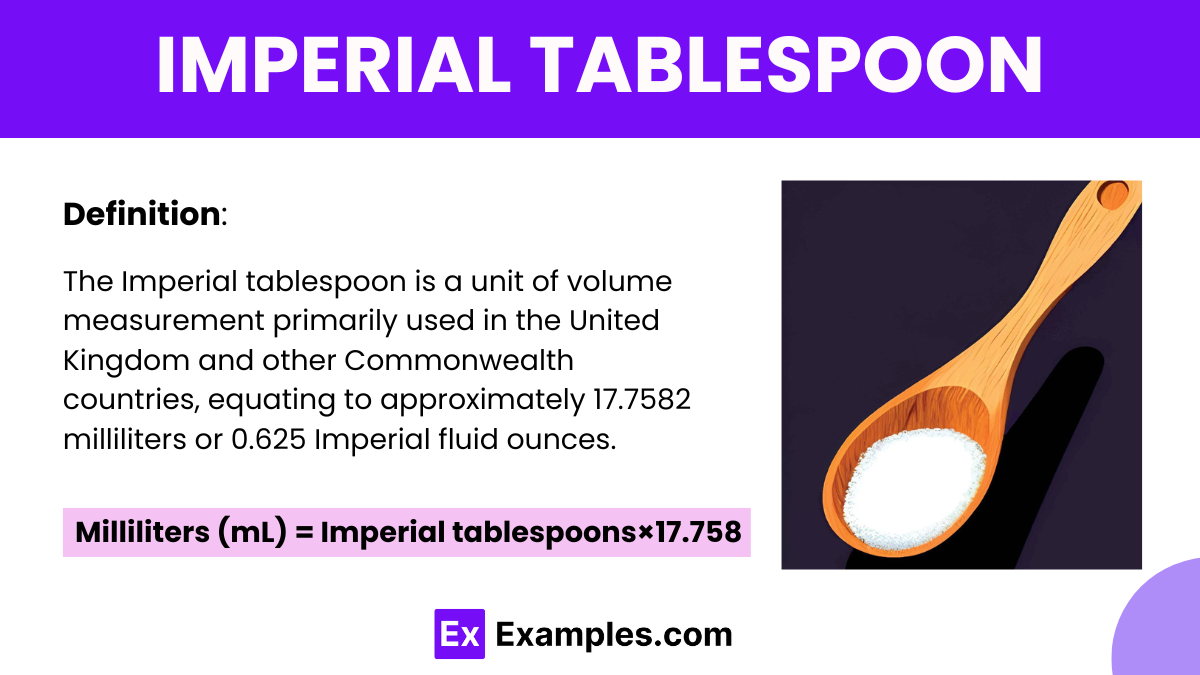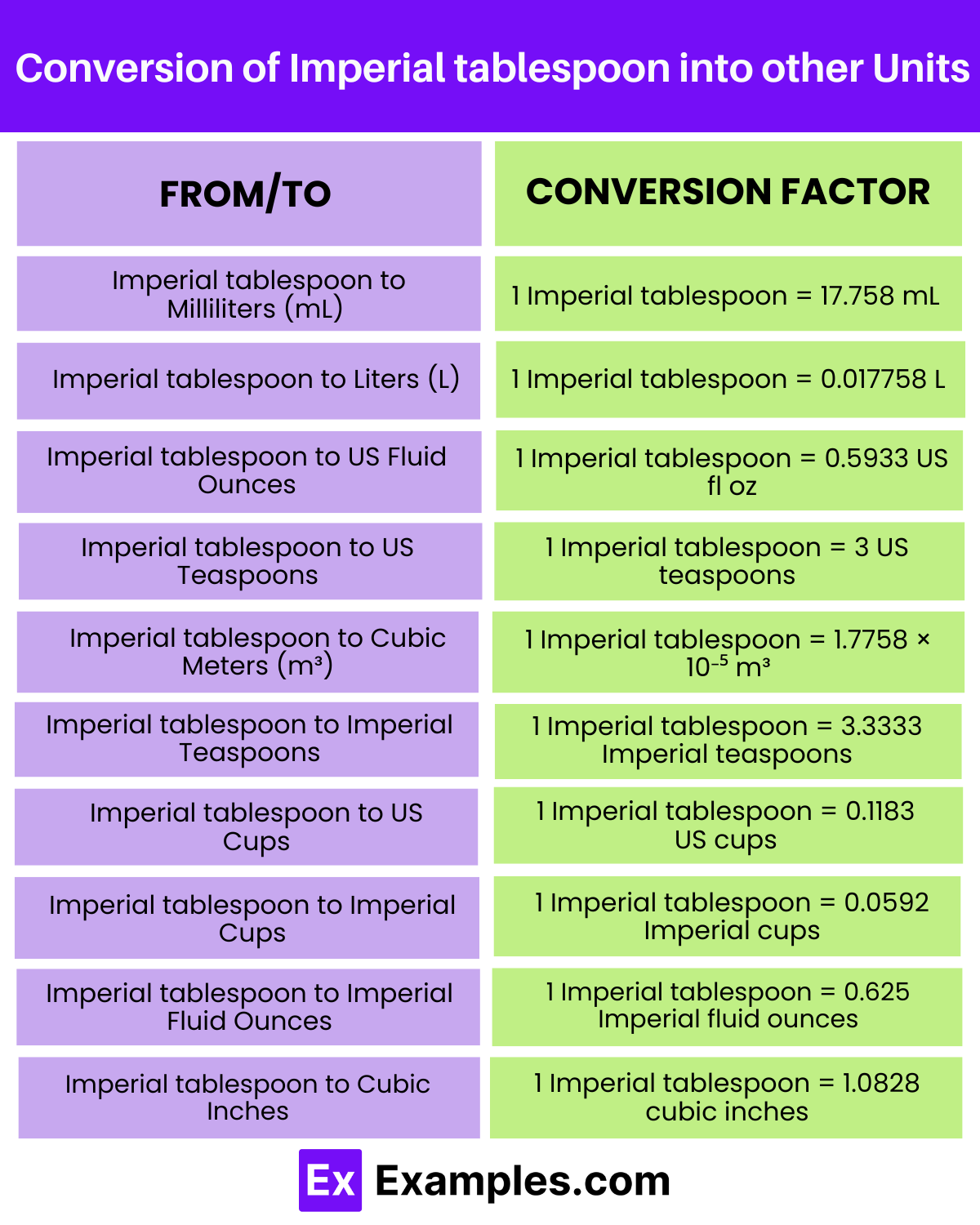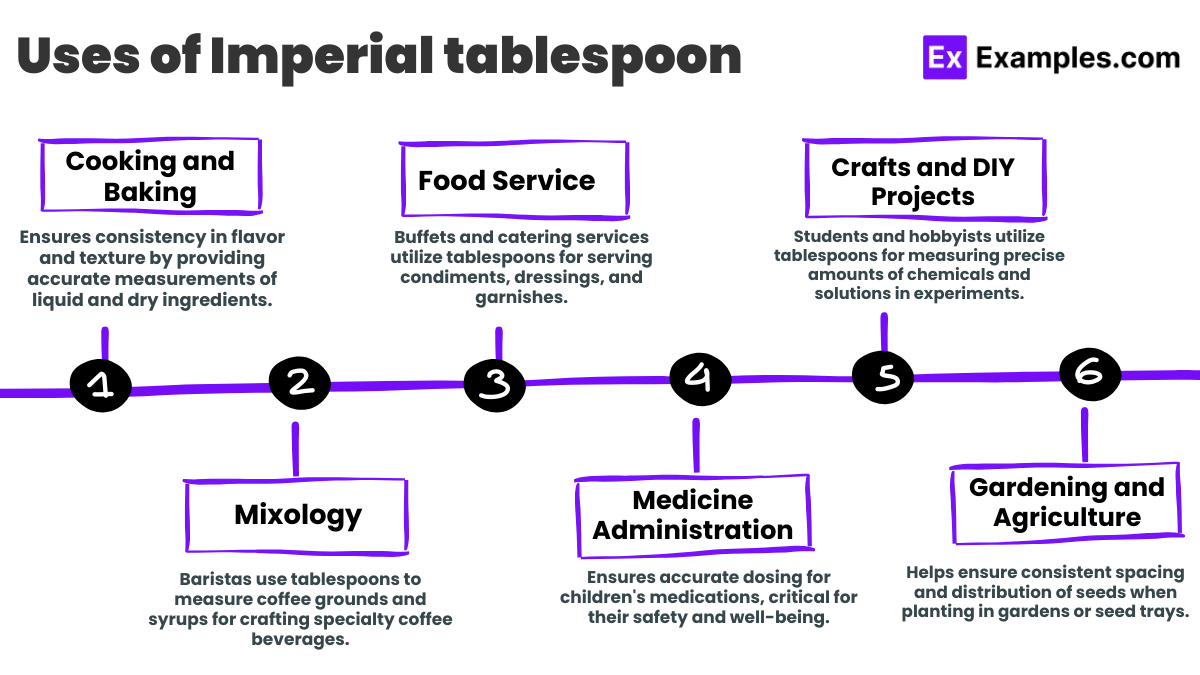How many milliliters are in one Imperial tablespoon?
15 mL
20 mL
25 mL
28.41 mL


The Imperial tablespoon is a units of volume measurement used in the British Imperial system and some Commonwealth countries. It is primarily utilized for measuring ingredients in cooking and baking, offering a standardized volume for precise recipe preparation. In the realm of volume measurements, the Imperial tablespoon plays a significant role alongside other units such as the US tablespoon, US fluid ounce, and US teaspoon. Understanding its relationship with these units is essential for accurate measurement in culinary applications, as well as in scientific fields where volume is a fundamental concept in physics and chemistry. While smaller in volume compared to units like the US liquid gallon or cubic meter, the Imperial tablespoon holds importance in everyday cooking and serves as a key component of standardized measurement systems.
Suppose you’re following a recipe that calls for 2 Imperial tablespoons of olive oil.
To determine how many milliliters of olive oil you need, you would use the conversion formula:
Milliliters (mL) = Imperial tablespoons×17.758
Milliliters (mL) = 2 Imperial tablespoons×17.758 mL/tablespoon
Milliliters (mL) = 35.516 mL
You would need approximately 35.52 milliliters of olive oil to fulfill the recipe’s requirement of 2 Imperial tablespoons. This calculation ensures precise measurement and accurate flavoring in your culinary creation.
The Imperial tablespoon is a unit of volume measurement commonly used in the British Imperial system. It’s equivalent to approximately 17.758 milliliters or 0.879 US fluid ounces. Here’s an explanation of how to use the Imperial tablespoon with an example:
| Feature | US Tablespoon | Imperial Tablespoon |
|---|---|---|
| Volume | Approximately 14.787 milliliters (mL) | Approximately 17.758 milliliters (mL) |
| Equivalence | 1 US tablespoon ≈ 0.5 US fluid ounces | 1 Imperial tablespoon ≈ 0.879 US fluid ounces |
| Standardization | Part of the US customary system of measurement | Part of the British Imperial system of measurement |
| Usage | Commonly used in the United States | Commonly used in the United Kingdom and Commonwealth |
| Metric Equivalence | 1 US tablespoon = approximately 14.787 mL | 1 Imperial tablespoon = approximately 17.758 mL |
| Culinary Applications | Widely used for cooking and baking in the US | Commonly employed for recipes in British cooking |
| SI Prefix | Multiplier | Equivalent Volume (milliliters) |
|---|---|---|
| Milli- (m) | 10⁻³ | 0.017758 mL |
| Centi- (c) | 10⁻² | 0.17758 mL |
| Deci- (d) | 10⁻¹ | 1.7758 mL |
| Base | 10⁰ | 17.758 mL |
| Deca- (da) | 10¹ | 177.58 mL |
| Hecto- (h) | 10² | 1775.8 mL |
| Kilo- (k) | 10³ | 17758 mL |

| To Unit | Conversion Factor | Example Conversion |
|---|---|---|
| Imperial tablespoon to Milliliters (mL) | 1 Imperial tablespoon = 17.758 mL | 10 Imperial tablespoons = 177.58 mL |
| Imperial tablespoon to Liters (L) | 1 Imperial tablespoon = 0.017758 L | 10 Imperial tablespoons = 0.17758 L |
| Imperial tablespoon to US Fluid Ounces | 1 Imperial tablespoon = 0.5933 US fl oz | 10 Imperial tablespoons = 5.933 US fl oz |
| Imperial tablespoon to US Teaspoons | 1 Imperial tablespoon = 3 US teaspoons | 10 Imperial tablespoons = 30 US teaspoons |
| Imperial tablespoon to Cubic Meters (m³) | 1 Imperial tablespoon = 1.7758 × 10⁻⁵ m³ | 10 Imperial tablespoons = 1.7758 × 10⁻⁴ m³ |
| Imperial tablespoon to Imperial Teaspoons | 1 Imperial tablespoon = 3.3333 Imperial teaspoons | 10 Imperial tablespoons = 33.333 Imperial teaspoons |
| Imperial tablespoon to US Cups | 1 Imperial tablespoon = 0.1183 US cups | 10 Imperial tablespoons = 1.183 US cups |
| Imperial tablespoon to Imperial Cups | 1 Imperial tablespoon = 0.0592 Imperial cups | 10 Imperial tablespoons = 0.592 Imperial cups |
| Imperial tablespoon to Imperial Fluid Ounces | 1 Imperial tablespoon = 0.625 Imperial fluid ounces | 10 Imperial tablespoons = 6.25 Imperial fluid ounces |
| Imperial tablespoon to Cubic Inches | 1 Imperial tablespoon = 1.0828 cubic inches | 10 Imperial tablespoons = 10.828 cubic inches |
Converting Imperial tablespoons to liters provides a broader perspective on volume, particularly useful when scaling up recipes or understanding liquid measurements in larger contexts such as beverage production or scientific experiments.
Converting Imperial tablespoons to these units offers versatility in volume measurement, catering to different culinary traditions and regional measurement systems.
It allows for seamless adaptation of recipes across various contexts and facilitates precise ingredient measurements in cooking and baking.
Converting Imperial tablespoons to these units offers versatility in volume measurement, catering to different culinary traditions and regional measurement systems.

An Imperial tablespoon is a unit of volume measurement commonly used in the British Imperial system. It differs from other tablespoon measurements, such as the US tablespoon.
While a regular tablespoon from a cutlery set may suffice for approximate measurements, it may not provide the accuracy required for precise recipe outcomes.
The Imperial tablespoon is frequently used to measure various liquid and dry ingredients in cooking and baking, including oils, sauces, spices, and condiments.
Text prompt
Add Tone
10 Examples of Public speaking
20 Examples of Gas lighting
How many milliliters are in one Imperial tablespoon?
15 mL
20 mL
25 mL
28.41 mL
What is the volume of an Imperial tablespoon in fluid ounces?
0.5 fl oz
0.8 fl oz
1.0 fl oz
1.2 fl oz
How many teaspoons are there in one Imperial tablespoon?
2 teaspoons
3 teaspoons
4 teaspoons
5 teaspoons
If a recipe calls for 3 Imperial tablespoons of an ingredient, how many milliliters would that be?
85.23 mL
90 mL
75 mL
70 mL
Convert 2 Imperial tablespoons to fluid ounces.
1.2 fl oz
1.6 fl oz
2.0 fl oz
2.4 fl oz
How many Imperial tablespoons are in one cup?
8 tablespoons
12 tablespoons
16 tablespoons
20 tablespoons
What is the approximate volume of 5 Imperial tablespoons in milliliters?
100 mL
120 mL
140 mL
150 mL
If you need 10 Imperial tablespoons of water, how many liters is that?
0.1841 L
0.2841 L
0.3841 L
0.4841 L
How many Imperial tablespoons are in a half cup?
4 tablespoons
6 tablespoons
8 tablespoons
10 tablespoons
Convert 1.5 Imperial tablespoons to milliliters.
35.61 mL
42.61 mL
25.61 mL
18.41 mL
Before you leave, take our quick quiz to enhance your learning!

